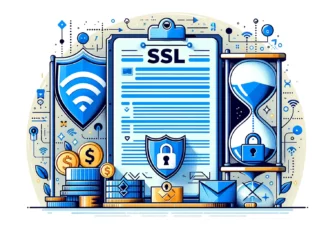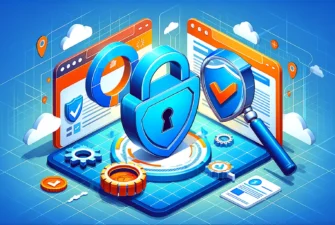
Do you ever wonder what keeps your online transactions secure? You’ve likely encountered X.509 certificates without even realizing it. They’re the unsung heroes of internet security.
In this article, we’ll dive deep into what an X.509 certificate is, how it works, and why it’s crucial in maintaining trust in the digital world.
Let’s unravel the complexities of these digital certificates so you understand what’s behind sensitive data protection.
Table of Contents
- What Is an x.509 Certificate?
- Components of an x.509 Certificate
- The Benefits of X.509 Certificates
- How Do x.509 Certificates Work?
- What Are the Main Uses of X.509 Public Key Infrastructure?
What Is an x.509 Certificate?
An X.509 certificate, a fundamental component of online security, is a standardized digital credential system defined by the Internet Engineering Task Force. They are widely recognized and implemented in security protocols such as SSL (Secure Sockets Layer) and TLS (Transport Layer Security). The X.509 standard defines the format and encoding of public key certificates.
Among them is the Distinguished Encoding Rules (DER) set of standards that ensure compatibility and consistent representation across different systems and applications.
These certificates are a crucial part of Public Key Infrastructure (PKI). They are commonly used in secure communications over the internet, such as for SSL/TLS encryption in web browsers and email encryption.
The X certificate comprises a public key and an identity – a name, serial number, or the entity location. It’s like a digital passport, providing proof of identity for a website or server. The certificate is issued by a trusted Certificate Authority (CA), ensuring the entity is who it claims to be.
This mechanism prevents malicious actors from impersonating legitimate websites or servers, safeguarding you from potential cyber threats. Understanding the role and function of an X.509 CA certificate helps you appreciate the complex, robust security measures protecting your digital life.
Components of an x.509 Certificate
Now, let’s move on to its key components. These include the version, serial number, algorithm information, issuer, and validity period. Understanding these elements will give you a deeper insight into how X.509 Certificates operate and establish secure connections.
Version Number
The version number identifies the format of the certificate. It provides valuable information about the type and structure of a digital certificate. X.509 certificates come in three different versions:
- v1: Basic information, lacks extensions.
- v2: Added subject and issuer key identifiers.
- v3: Most common, rich in extensions like Subject Alternative Name, Key Usage, and more for detailed certificate information.
You’ll find the version number in the “Version” field of the certificate, and it’s essential for both the issuer and the recipient of the certificate to interpret the certificate’s structure correctly.
Older systems or applications may only support v1 or v2 certificates, while modern applications typically work with v3, taking advantage of the additional features and web server security enhancements they offer.
Serial Number
A serial number in an X.509 certificate is a unique identifier that distinguishes the CA certificate from other certificates. This number is assigned by the Certificate Authority during certificate creation, ensuring that no two certificates are the same.
It helps track and revoke certificates if necessary, and it aids in preventing misuse. A Certificate Revocation List (CRL) is an essential aspect of X.509, informing users and systems about revoked certificates before their expiration. When viewing a certificate, the serial number is in a hexadecimal format.
Algorithm Information
Here’s how algorithm information functions in X.509 digital certificates:
- The signature algorithm is defined, which sets the rules for Public Key Cryptography.
- The certificate’s key pair is generated based on this algorithm.
- The certificate’s public key is then used to encrypt data, while the private key decrypts it.
- The signature algorithm verifies the certificate’s integrity, ensuring it’s not tampered with.
Issuer
The issuer, also known as the certificate issuer, is the entity that verifies and signs the certificate. It’s usually an issuing certificate authority trusted by the system or network.
The issuer plays an essential role in the credibility and functionality of an X.509 certificate. If browsers or apps don’t trust it or can’t verify the digital signature, the certificate is considered invalid.
Validity Period (Start and End Dates)
This validity period signifies how long the certificate is deemed trustworthy. Commercial certificates have a lifespan of just one year. Renewing them before the expiry date prevents SSL connection errors and website outages. Self signed certificates have no expiration date.
Subject (Entity the Certificate Represents)
You can identify the subject by distinguished names (DNs) within the certificate contents. The subject field includes the legal name of the entity, its location, and other relevant details.
In addition, a subject alternative name extension allows for extra identities to be associated with the same entity, for instance, multiple domain names or IP addresses. This extension secures multi-domain or multi-subdomain environments.
Subject Public Key Information
This section contains the following info:
- The public key, which anyone can share to encrypt data, but only holders of the corresponding private keys can decrypt it.
- The algorithm. Commonly used ones are RSA, DSA, and ECC.
- The key parameters of the algorithm used.
- Key usages such as digital signature, non-repudiation, or encipherment.
Certificate Extensions
These are additional certificate fields within the certificate that provide more specific information or functionality.
Key usage, for instance, specifies the cryptographic operations that can be performed with the associated key, such as data encryption or signature verification.
On the other hand, extended key usage is a more specific version of key usage. It dictates the exact purposes for which the certificate can be used. For instance, it might be restricted to server authentication, client authentication, or code signing.
Signature (from Certification Authorities)
The digital signature confirms that the CA vouches for the authenticity of the information in the certificate. The CA creates it through a process that takes a hash of the certificate’s content and encrypts it using its private key.
This encrypted hash is the digital signature attached to the certificate. Anyone with the CA public key can verify it.
Now that you know the x 509 certificate components, let’s see what benefits they offer.
The Benefits of X.509 Certificates
As we explore the benefits of X.509 certificates, three key advantages stand out: authentication, data encryption, and non-repudiation.
1. Authentication
X.509 certificates significantly enhance online authentication, making it more secure and reliable by leveraging the power of digital certificates. They manage identity, ensuring you’re sharing sensitive data with who you think you are and not a scammer at the other end.
2. Data Encryption
By employing public key encryption, such certificates ensure confidentiality and data integrity. When you send data, it’s encrypted using the recipient’s public key and decrypted with their private key. So your data remains secure from unauthorized access.
After data encryption, any alteration of the data, whether intentional or accidental, is detected. The recipient’s decryption process checks data consistency, verifying it hasn’t been tampered with in transit.
3. Non-Repudiation
Non-repudiation ensures undeniable proof of message origin and integrity. It confirms that the claimed sender sent the encrypted message and verifies that it hasn’t been tampered with during transmission.
Non-repudiation offers legal evidence in disputes, as the sender can’t deny the action. It boosts trust and accountability between communicating parties.
After exploring the main benefits, let’s see how x 509 certificates work in greater detail:
How Do x.509 Certificates Work?
To understand how X.509 certificates work, you first need to grasp what Public Key Infrastructure (PKI) is, as this is the framework on which these certificates operate.
An integral part of this system is the Certification Authority, the entity that issues the certificates. The process of obtaining a certificate involves a Certificate Signing Request (CSR), and once established, these certificates use digital signatures to ensure trust.
Description of Public Key Infrastructure (PKI)
PKI is a set of roles, policies, hardware, software, and procedures necessary to create, manage, distribute, use, store, and revoke digital certificates. It involves two keys: a public key, which is freely available, and a private key, kept secret by the owner.
The X.509 certificate is the element of the PKI that binds a public key with an identity. This certificate is signed by a certificate authority, ensuring its authenticity.
Role of Certificate Authorities
Certificate Authorities issue, verify, and manage X.509 certificates, widely known as SSL or TLS certificates. When someone requests a cert, the CA validates the requester’s identity and generates a certificate.
The X.509 certificate issued includes the public key of the requester and the digital signature of the CA. It’s part of the SSL certificate chains of trust, which also feature the root certificates and intermediate certificates.
When you connect to a secure website, your browser checks the certificate’s digital signature against the trusted CAs in its certificate store. If it’s valid, the browser establishes a secure connection.
Certificate Signing Request (CSR)
So, how do you go about obtaining an X.509 certificate? You’ll need to go through a certificate signing request (CSR). It’s the same thing as buying an SSL certificate. Here is a step-by-step rundown of the process:
- Generate a private-public key pair: This is your unique identifier.
- Create a CSR: This includes your public key and some personal information. You can perform the first two steps using our Generator tool.
- Send the CSR to the issuing CA. The CA will verify your identity and your CSR, then deliver the certificate files via email.
Digital Signatures and How X.509 Certificates Establish Trust
Digital signatures are cryptographic elements that validate the identity of the sender and the integrity of the data transmitted. They’re created using a private key that only the sender knows.
When you receive a digitally signed message, you use the sender’s public key, embedded in their X.509 certificate, to validate the signature. This process fosters trust as it assures you that the message is indeed from the claimed sender and hasn’t been altered.
What Are the Main Uses of X.509 Public Key Infrastructure?
You might wonder how X.509 Public Key Infrastructure works in the real world.
It’s frequently utilized for SSL/TLS, securing web browsing by establishing encrypted links between a web server and a browser.
Additionally, we use it in email encryption and signing (S/MIME), code signing, granting VPN access, and creating digital documents.
SSL/TLS for Secure Web Browsing
When a browser initiates a secure connection with a web server, the server responds with its X.509 certificate containing its public key. The browser then validates the certificate’s authenticity by confirming its validity.
If the certificate is valid, the browser employs the public key to encrypt a session key, establishing a secure and encrypted connection. This SSL/TLS protocol safeguards data during transmission, forming a crucial component of modern internet security.
Email Encryption and Signing (S/MIME)
As a standard for encrypted email encoding schema, S/MIME (Secure/Multipurpose Internet Mail Extensions) uses X.509 certificates to ensure the authenticity and integrity of encrypted emails.
The sender’s client signs the outgoing email with the sender’s private key and then encrypts it with the recipient’s public key. The recipient’s client, in turn, decrypts the email using the recipient’s private key and then verifies the signature using the sender’s public key.
This process ensures that only the intended recipient can read the email and that the email hasn’t been tampered with en route.
Code Signing
Code signing authenticates the software source: The certificate confirms that the software comes from a known publisher, enhancing user trust.
It ensures the software hasn’t been fiddled with since its signing, preventing potential security breaches.
The code signing certificate encourages safer downloads from the internet, minimizing the risk of malware infiltration. It binds the code to a specific entity, discouraging malicious practices.
Hence, code signing, backed by X.509 certificates, is essential in maintaining a secure digital ecosystem.
VPN Access
The X.509 certificates provide secure connections by encrypting data between your device and the VPN server. This encryption prevents unauthorized access, ensuring your data remains private and secure.
The VPN access point verifies the authenticity of the X.509 certificate before establishing a safe connection. The validation process helps ward off potential spoofing attacks. If the certificate isn’t valid or has been tampered with, you won’t be able to establish a secure connection.
Digital Document Signatures
X.509 certificates validate documents. They verify your digital document signatures, confirming you’re the legitimate sender. The receiver can check if the document has been altered during the personal information exchange. Moreover, you can’t deny authorship, which is crucial in legal settings, and can secure the documents’ contents against unauthorized access. Thanks to X.509 certs, document signing is quick and easy.
FAQ
Is x.509 the Same as SSL?
No. x.509 is a standard for digital certificates. SSL (and TLS) are protocols that use these certificates for secure communications.
Is x.509 a PKI?
No. x.509 is a component of the PKI, not the entire infrastructure.
Why Is It Called x.509?
It originates from the ITU-T X series of standards.
Is x.509 Certificate Public or Private?
The x.509 certificate contains the public key, while the corresponding private key remains confidential.
Do x.509 Certificates Expire?
Yes, they have a validity period and need renewal post-expiration.
What Is the Difference Between RSA and x.509?
RSA is a cryptographic algorithm. x.509 is a standard for digital certificates.
What Is the Difference Between an SSH Cert and an x.509 Cert?
SSH certificates facilitate secure shell access, while x.509 ensures broad secure communications.
What Is the Difference Between x.509 and PEM?
PEM (Privacy Enhanced Mail) is a file format. It can represent x.509 certificates and other data types.
Conclusion
In conclusion, X.509 digital certificates are indispensable in the digital world, particularly computer networking. With their ability to establish trust, encrypt data, and provide non-repudiation, X.509 certificates support critical aspects of our online lives, from secure web browsing and email encryption to code signing and VPN access.
In an increasingly data-driven world, this technology ensures that our digital transactions and communications remain safe and reliable.
Save 10% on SSL Certificates when ordering today!
Fast issuance, strong encryption, 99.99% browser trust, dedicated support, and 25-day money-back guarantee. Coupon code: SAVE10



























